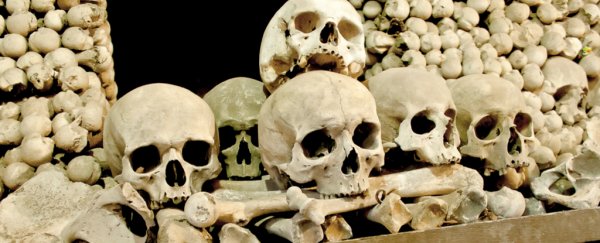Plague came to Europe in the 14th century and rapidly conquered the continent. The pandemic, one of the worst in human history, killed tens of millions.
Up to 60 percent of the population succumbed to the bacteria called Yersinia pestis during outbreaks that recurred for 500 years. The most famous outbreak, the Black Death, earned its name from a symptom: lymph nodes that became blackened and swollen after bacteria entered through the skin.
Yet even now, the "biggest conundrum in the field" is the physical mechanism that hastened plague's swift spread, said Monica Green, a historian at Arizona State University and an expert in medieval European health.
A study published recently in the Proceedings of the National Academy of Sciences suggests an answer - and it points primarily to lice and fleas, not rodent culprits.
In the long-popular theory of bubonic plague, rats, gerbils or other rodents acted as bacteria banks. The fleas that bit infected rats then jumped to humans and started feasting. "It sucked me first, and now sucks thee,/And in this flea our two bloods mingled be;" poet John Donne wrote in the 17th century.
What Donne did not know, because he died several decades before the discovery of microbes, is that bacteria also mingled with bodily fluids.
"The classic example is the rat-flea transmission," said lead study author Katharine Dean, a research fellow at the University of Oslo who studies infectious disease.
But rodents have been unfairly maligned for their role in the pandemic, per a new mathematical model developed by Dean and her colleagues in Norway.
The scientists generated a list of plague characteristics based upon contemporary field observations, experimental data or best estimates.
For instance: The probability that someone could recover from the plague was 40 percent. A louse carrying plague bacteria remained infectious for a period of about three days. A person could carry an average of six fleas.
Some crucial information remains unknown. "It's very hard to grow human fleas in the lab," she said. The length of an infectious period depends on whether the bacteria simply coat the parasite's mouth parts or move into its intestines.
Mortality records from several centuries provided the most critical detail, said study co-author Boris Schmid, a computational biologist at the University of Oslo.
Observers could document the rise and fall in plague deaths per week because the disease was so virulent and the signs of infection so obvious, he said. (However, some historians have questioned using such contemporary accounts to explain plague activity.)
Using these parameters, the scientists modeled three scenarios. In one, lice and fleas spread the plague. In another, rodents plus their parasites spread the plague. In a third, coughing humans spread an airborne version of the disease, called pneumonic plague.
The rodent model did not match the historical death rates. The plague must first work its way through the rodent population, at which point the disease bursts into humans. The modeled result was a delayed but very high spike in deaths, which the mortality data does not reflect. The pneumonic plague model also did not fit.
"Human body lice or fleas were the main transmission routes in medieval pandemics," Schmid said.
It's a "plausible" theory, noted Nükhet Varlık, a professor of history at Rutgers University in New Jersey who has studied the plague in the Ottoman Empire.
But she criticised the focus of the new research "exclusively on the European experience. Plague spread across Afro-Eurasia during the Black Death and continued on and off for several centuries."
Plague outbreaks still occur. The disease was suspected or confirmed in 171 deaths from August through November 10 in Madagascar, according to the World Health Organisation.
"As the recent outbreak in Madagascar has shown us, we have likely been underestimating pneumonic plague (person-to-person transmission by coughing) as a factor in high-mortality events," Green wrote in an email.
Schmid said the new study's modelling, though it suggests parasites have dominated the spread of plague historically, does not discount other means of transmission. There is value, he said, in studying these long-ago outbreaks.
"It is the best example in time we have of a disease coming from the wild and spreading like wildfire."
2017 © The Washington Post
This article was originally published by The Washington Post.
